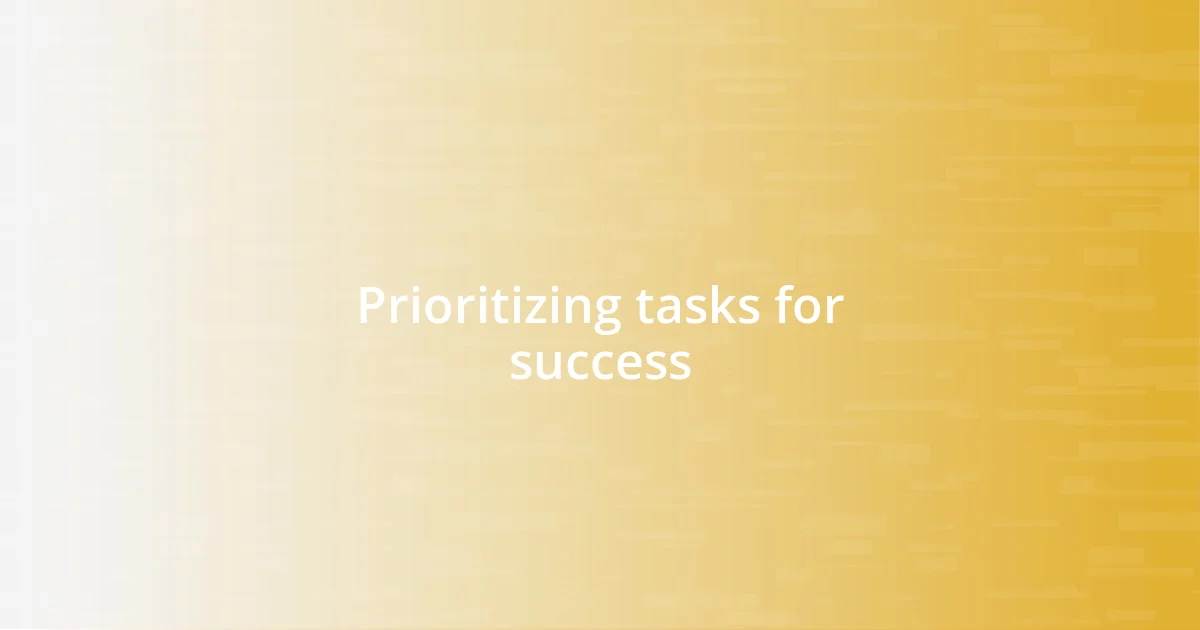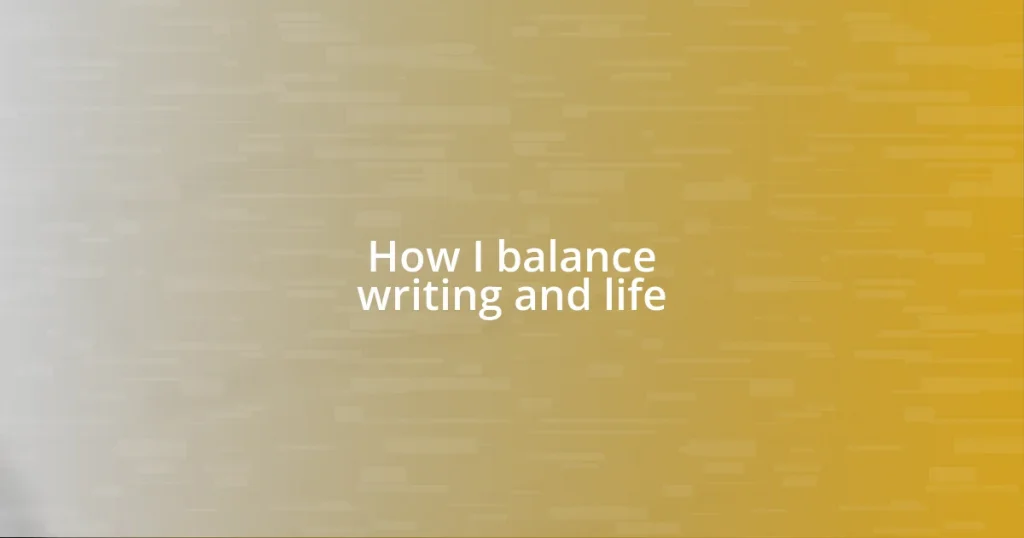Key takeaways:
- Understanding the distinction between urgent and important tasks enhances productivity; using a prioritization matrix can help clarify this.
- Setting specific, measurable goals provides clarity, motivation, and a sense of purpose, significantly boosting overall performance.
- Employing techniques such as the Pomodoro Technique and time-tracking apps fosters better focus and time management, leading to increased productivity and accountability.

Understanding time management concepts
Time management isn’t just about making to-do lists or scheduling appointments; it’s about understanding priorities and setting realistic goals. I remember a time when I overloaded my plate with tasks because I thought I could handle it all. Reflecting on that experience, I often ask myself: what was I thinking? Recognizing the importance of prioritization transformed my approach to daily tasks.
Another critical concept is the difference between urgent and important tasks. I’ve had moments when I felt overwhelmed by urgent emails, only to realize later they didn’t contribute to my long-term goals. This realization sparked an essential question: how can we differentiate between what feels urgent and what truly matters? I began using a simple matrix, categorizing tasks into four quadrants, which made a world of difference in my productivity.
Lastly, I’ve learned that time management is deeply personal. What works for one person may not work for another. There was a time I tried to adopt a popular productivity method, but it felt forced and didn’t fit my style. I invite you to reflect: what strategies resonate with you? Embracing a personalized approach has been key to making time management an effective tool in my life.

Importance of setting goals
Setting goals is more than just jotting down what we want to achieve; it’s about creating a roadmap for our lives. I still recall the feeling of uncertainty when I started my first job without a clear vision of what I wanted to accomplish. It was like wandering through a maze—exciting yet disorienting. After setting specific, measurable goals, I noticed a dramatic shift in my motivation and focus. Suddenly, every task felt purposeful, each small victory contributed to a bigger picture, and I found myself embracing challenges rather than shying away from them.
To emphasize the importance of goal-setting, consider these points:
- Clarity: Goals provide a clear direction, making it easier to prioritize tasks.
- Motivation: Specific objectives ignite passion and drive, pushing us to persevere through difficulties.
- Measure progress: With defined goals, tracking your progress becomes straightforward, allowing for timely adjustments.
- Confidence boost: Achieving goals—even tiny ones—builds self-esteem and encourages you to take on even more ambitious targets.
Each of these aspects has made a significant difference in my daily life, shaping how I approach both personal and professional endeavors. Setting goals is not just about the end result; it’s about enhancing my journey along the way.

Techniques for effective time tracking
Tracking time effectively can significantly impact productivity, and I’ve discovered a few techniques that truly resonate with me. One method that has worked wonders is using a time-tracking app. I started with a simple app that allows me to categorize tasks and see where my hours went each day. Initially, I was pleasantly surprised by the insights I gained; I didn’t realize how much time I was spending on social media while working. This realization prompted me to set stricter boundaries, which ultimately led to more productive hours.
Another technique that I’ve incorporated is the Pomodoro Technique, where I work in focused bursts of 25 minutes followed by a 5-minute break. I was skeptical at first—could five minutes really make a difference? However, after trying it for a week, I found that those short breaks allowed my mind to recharge, leading to significantly improved focus. I can personally attest that this method not only helped me stay engaged but also made my work feel less daunting.
Finally, maintaining a daily journal to reflect on how I spent my time has been invaluable. Each evening, I jot down what I accomplished and areas where I can improve. This reflection process has introduced a sense of accountability, reminding me to stay true to my goals. It’s like holding up a mirror; some days, I’m pleased with what I see, and other days, I realize there’s room for growth. These techniques have formed a robust foundation for my time management strategy.
| Technique | Description |
|---|---|
| Time-Tracking Apps | Applications that record how much time you spend on various tasks, allowing you to analyze and adjust your habits. |
| Pomodoro Technique | A time management method that uses intervals of focused work (25 minutes) followed by short breaks (5 minutes). |
| Daily Journaling | Reflecting on daily activities to assess productivity and identify areas for improvement. |

Prioritizing tasks for success
When it comes to prioritizing tasks for success, I often encourage myself to think about what truly matters. One day, I found myself overwhelmed with a lengthy to-do list, which led me to ask, “What would make the most impact today?” That simple question shifted my focus to crucial tasks that aligned with my long-term goals, allowing me not just to check things off my list but to feel a sense of real accomplishment.
I’ve experimented with the Eisenhower Matrix, a tool that helps categorize tasks by urgency and importance. Honestly, the first time I mapped out my tasks, it was eye-opening. I saw how many activities were simply “urgent” but not “important,” like responding to non-essential emails. By identifying these tasks, I could delegate or even eliminate them, freeing up time for what really drives my success. It made me realize: not everything that screams for my attention deserves it.
Reflecting on my experiences, I’ve learned that prioritization is an ongoing process. For instance, I remember the time I had a big presentation at work. Instead of diving straight into preparation, I first prioritized my research and created an outline. This methodical approach not only built my confidence but also ensured I delivered my message effectively. So, how do you prioritize your tasks? I believe it’s worth evaluating regularly. What shifts in your routine could pave the way for greater success?

Overcoming procrastination challenges
Procrastination is a challenge that often feels insurmountable, but I’ve found that understanding its roots is the first step to overcoming it. I remember a time when I would put off packing for a big trip, convincing myself that I needed to “get in the mood” first. By recognizing that my procrastination stemmed from feeling overwhelmed, I could tackle it head-on. That insight led me to break down the task into smaller, manageable steps, which made the process far less daunting.
One strategy that profoundly changed my approach to procrastination was implementing “temptation bundling.” For instance, I love listening to podcasts, but I often found myself avoiding less enjoyable tasks, like organizing my desk. By combining these tasks—allowing myself to listen to a podcast only while I worked on my desk cleanup—I discovered that I could turn a dreaded task into something I looked forward to. Have you ever tried this approach? Finding a way to make tedious chores more enjoyable can create a strong incentive to get started.
Additionally, the environment plays a crucial role in procrastination. I once found myself struggling to study for an important exam while sitting in a cluttered space. After realizing how distracting my surroundings were, I dedicated time to declutter my study area, creating a serene environment that helped me focus. I cannot emphasize enough the power of a clean workspace—what’s your environment saying about your productivity habits? Sometimes, a simple refresh can ignite motivation in ways we didn’t anticipate.

Tools for improved time management
I’ve found that digital tools have been game-changers for my time management. One of my favorites is Todoist, an app that helps me organize tasks and set priorities. The satisfaction of checking off completed items gives me a little boost, almost like a mini-celebration for my productivity. Plus, its ability to integrate with other platforms means I can access my tasks wherever I am. Have you ever considered how a simple notification can encourage you to stay on track?
Another tool that revolutionized my routine is the Pomodoro Technique. I remember feeling drained during long study sessions, often zoning out halfway through. Once I started using a timer, I’d work in focused bursts of 25 minutes, followed by short breaks. It felt like I could breathe again! I realized I was not only more productive but also retained information better. What do you think—could such a system help you reclaim your focus during hectic days?
Lastly, I’ve recently embraced time-blocking in my calendar. Instead of leaving my day open-ended, I allocate specific slots for tasks, and it’s been a revelation. Recently, I noticed I’d been spending way too much time on social media, so I scheduled only 15-minute breaks for it. Holding myself to that time limit transformed how I interact with my phone. How do you currently manage your distractions? Setting boundaries like this can create a healthier balance and elevate your efficiency.















